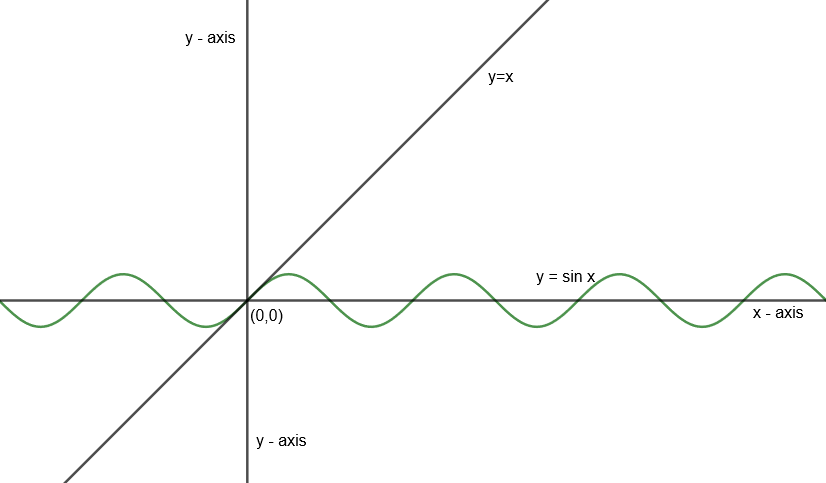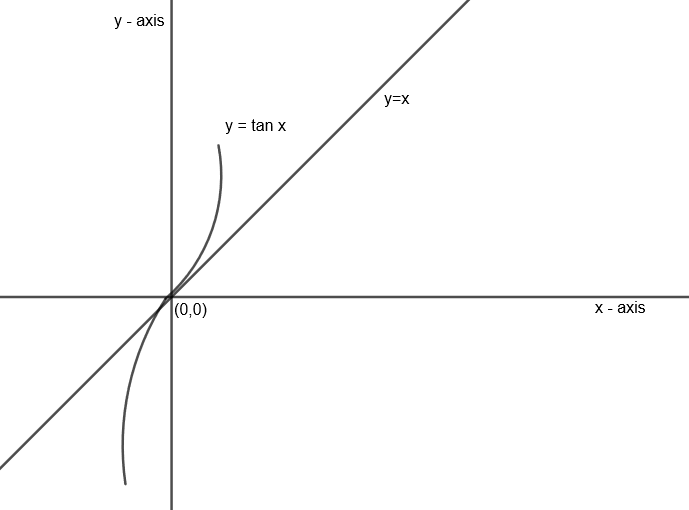
Let $\underset{x\to 0}{\mathop{\lim }}\,{{\sec }^{-1}}\left( \dfrac{x}{\sin x} \right)=l$ and \[\underset{x\to 0}{\mathop{\lim }}\,{{\sec }^{-1}}\left( \dfrac{x}{\tan x} \right)=m\], then
(a) l exists but m does not
(b) m exists but l does not
(c) l and m both exist
(d) neither l nor m exists
Answer
606.3k+ views
Hint: Relate the relation between x, sin x and tan x when x is limiting to zero. Relate it with the domain of \[{{\sec }^{-1}}x\] for existing limits.
Here, we have given the limits as
$\underset{x\to 0}{\mathop{\lim }}\,{{\sec }^{-1}}\left( \dfrac{x}{\sin x} \right)=l....\left( i \right)$
And, \[\underset{x\to 0}{\mathop{\lim }}\,{{\sec }^{-1}}\left( \dfrac{x}{\tan x} \right)=m.....\left( ii \right)\]
First, we need to know about the domain of \[{{\sec }^{-1}}x\] i.e. \[\left( -\infty ,-1 \right]\cup \left[ 1,\infty \right)\].
Now, try to relate values of \[\dfrac{x}{\sin x}\] and \[\dfrac{x}{\tan x}\] for limit \[x\to 0\], if value inside of \[{{\sec }^{-1}}\left( {} \right)\] will lie in \[\left( -1,1 \right)\] then limit will not exist and if value inside the bracket lies in \[\left( -\infty ,-1 \right]\cup \left[ 1,\infty \right)\]. Hence limit will exist.
Let us first relate \[\dfrac{x}{\sin x}\].
One can relate x with sin x and tan x by calculating tangent equations of tan x and sin x at (0, 0) and relate it with y = x.
We know that one can find tangent at any point lying on the curve by calculating slope at that point. Let the point be \[\left( {{x}_{1}},{{y}_{1}} \right)\] and curve is y = f (x) then tangent at \[\left( {{x}_{1}},{{y}_{1}} \right)\] can be given by \[y-{{y}_{1}}={{\left. \dfrac{dy}{dx} \right|}_{\left( {{x}_{1}},{{y}_{1}} \right)}}\left( x-{{x}_{1}} \right)\]
Tangent equation for sin x at (0, 0) is
\[y-0={{\left. \dfrac{d}{dx}\left( \sin x \right) \right|}_{\left( 0,0 \right)}}\left( x-0 \right)\]
\[y={{\left. \cos x \right|}_{\left( 0,0 \right)}}\left( x \right)\text{ }\left[ \because \dfrac{d}{dx}\sin x=\cos x \right]\]
\[y=x\]
Hence, \[y=x\] is tangent for \[y=\sin x\].
Draw graph of x and sin x in one coordinate plane as follows:

Now for the second case i.e. \[\dfrac{x}{\tan x}\], we get the tangent equation of tan x at (0, 0) is
\[y-0={{\left. \dfrac{dy}{dx} \right|}_{\left( 0,0 \right)}}\left( x-0 \right)\]
\[y={{\left. {{\sec }^{2}}x \right|}_{\left( 0,0 \right)}}\left( x \right)\text{ }\left[ \dfrac{d}{dx}\tan x={{\sec }^{2}}x \right]\]
\[y=x\]
Hence, y = x is tangent for \[y=\tan x\] as well.
Let us draw the graph of x and tan x as follows:
 Now from the graphs, we can relate for \[\dfrac{x}{\sin x}\] that is:
Now from the graphs, we can relate for \[\dfrac{x}{\sin x}\] that is:
Case 1: \[x\to {{0}^{+}}\]
We observe x > sin x
Hence, \[\dfrac{x}{\sin x}>1\]
Case 2: \[x\to {{0}^{-}}\]
Here, sin x has a higher positive magnitude than x. Hence, if we put a negative sign to both x and sin x, then
\[x>\sin x\]
\[\dfrac{x}{\sin x}>1\]
Hence, from case 1 and case 2, we get
If \[\lim x\to 0,\] then \[\dfrac{x}{\sin x}>1....\left( iii \right)\]
Similarly, let us relate x and tan x for \[x\to 0\]
Case 1: \[x\to {{0}^{+}}\]
x < tan x
\[\dfrac{x}{\tan x}<1\]
Case 2: \[x\to {{0}^{-}}\]
x < tan x
\[\dfrac{x}{\tan x}<1\]
Hence, for \[x\to 0\], we have \[\dfrac{x}{\tan x}<1....\left( iv \right)\]
Now, for limit ‘l’ from equation (i), we get
\[l=\underset{x\to 0}{\mathop{\lim }}\,{{\sec }^{-1}}\left( \dfrac{x}{\sin x} \right)\]
As we have \[\dfrac{x}{\sin x}>1\] from equation (iii) and domain of \[{{\sec }^{-1}}x\] is \[\left( -\infty ,-1 \right]\cup \left[ 1,\infty \right)\] as explained in the starting. Hence, we can put \[\lim x\to 0\] to the given relation.
So, \[l=\underset{x\to 0}{\mathop{\lim }}\,{{\sec }^{-1}}\left( \dfrac{x}{\sin x} \right)\] will exist.
For limit ‘m’ from equation (ii), we get
\[m=\underset{x\to 0}{\mathop{\lim }}\,{{\sec }^{-1}}\left( \dfrac{x}{\tan x} \right)\]
We have already calculated that \[\dfrac{x}{\tan x}<1\] from equation (iv) and domain of \[{{\sec }^{-1}}x\] is \[\left( -\infty ,-1 \right]\cup \left[ 1,\infty \right)\]. Hence the given limit will not exist.
Hence, option (a) is the correct answer to the given problem.
Note: One can directly put \[\underset{x\to 0}{\mathop{\lim }}\,\dfrac{x}{\sin x}=1\] and \[\underset{x\to 0}{\mathop{\lim }}\,\dfrac{x}{\tan x}=1\] as we generally use but that will be wrong for the given expression. As the exact value of \[\underset{x\to 0}{\mathop{\lim }}\,\dfrac{x}{\sin x}\] and \[\underset{x\to 0}{\mathop{\lim }}\,\dfrac{x}{\tan x}\] is not exactly 1, it’s the limiting value of the given expressions. Hence, be careful with these kinds of problems. Relating x with tan x and sin x by calculating tangent at (0, 0) for sin x and tan x is the key point of the question.
Here, we have given the limits as
$\underset{x\to 0}{\mathop{\lim }}\,{{\sec }^{-1}}\left( \dfrac{x}{\sin x} \right)=l....\left( i \right)$
And, \[\underset{x\to 0}{\mathop{\lim }}\,{{\sec }^{-1}}\left( \dfrac{x}{\tan x} \right)=m.....\left( ii \right)\]
First, we need to know about the domain of \[{{\sec }^{-1}}x\] i.e. \[\left( -\infty ,-1 \right]\cup \left[ 1,\infty \right)\].
Now, try to relate values of \[\dfrac{x}{\sin x}\] and \[\dfrac{x}{\tan x}\] for limit \[x\to 0\], if value inside of \[{{\sec }^{-1}}\left( {} \right)\] will lie in \[\left( -1,1 \right)\] then limit will not exist and if value inside the bracket lies in \[\left( -\infty ,-1 \right]\cup \left[ 1,\infty \right)\]. Hence limit will exist.
Let us first relate \[\dfrac{x}{\sin x}\].
One can relate x with sin x and tan x by calculating tangent equations of tan x and sin x at (0, 0) and relate it with y = x.
We know that one can find tangent at any point lying on the curve by calculating slope at that point. Let the point be \[\left( {{x}_{1}},{{y}_{1}} \right)\] and curve is y = f (x) then tangent at \[\left( {{x}_{1}},{{y}_{1}} \right)\] can be given by \[y-{{y}_{1}}={{\left. \dfrac{dy}{dx} \right|}_{\left( {{x}_{1}},{{y}_{1}} \right)}}\left( x-{{x}_{1}} \right)\]
Tangent equation for sin x at (0, 0) is
\[y-0={{\left. \dfrac{d}{dx}\left( \sin x \right) \right|}_{\left( 0,0 \right)}}\left( x-0 \right)\]
\[y={{\left. \cos x \right|}_{\left( 0,0 \right)}}\left( x \right)\text{ }\left[ \because \dfrac{d}{dx}\sin x=\cos x \right]\]
\[y=x\]
Hence, \[y=x\] is tangent for \[y=\sin x\].
Draw graph of x and sin x in one coordinate plane as follows:

Now for the second case i.e. \[\dfrac{x}{\tan x}\], we get the tangent equation of tan x at (0, 0) is
\[y-0={{\left. \dfrac{dy}{dx} \right|}_{\left( 0,0 \right)}}\left( x-0 \right)\]
\[y={{\left. {{\sec }^{2}}x \right|}_{\left( 0,0 \right)}}\left( x \right)\text{ }\left[ \dfrac{d}{dx}\tan x={{\sec }^{2}}x \right]\]
\[y=x\]
Hence, y = x is tangent for \[y=\tan x\] as well.
Let us draw the graph of x and tan x as follows:

Case 1: \[x\to {{0}^{+}}\]
We observe x > sin x
Hence, \[\dfrac{x}{\sin x}>1\]
Case 2: \[x\to {{0}^{-}}\]
Here, sin x has a higher positive magnitude than x. Hence, if we put a negative sign to both x and sin x, then
\[x>\sin x\]
\[\dfrac{x}{\sin x}>1\]
Hence, from case 1 and case 2, we get
If \[\lim x\to 0,\] then \[\dfrac{x}{\sin x}>1....\left( iii \right)\]
Similarly, let us relate x and tan x for \[x\to 0\]
Case 1: \[x\to {{0}^{+}}\]
x < tan x
\[\dfrac{x}{\tan x}<1\]
Case 2: \[x\to {{0}^{-}}\]
x < tan x
\[\dfrac{x}{\tan x}<1\]
Hence, for \[x\to 0\], we have \[\dfrac{x}{\tan x}<1....\left( iv \right)\]
Now, for limit ‘l’ from equation (i), we get
\[l=\underset{x\to 0}{\mathop{\lim }}\,{{\sec }^{-1}}\left( \dfrac{x}{\sin x} \right)\]
As we have \[\dfrac{x}{\sin x}>1\] from equation (iii) and domain of \[{{\sec }^{-1}}x\] is \[\left( -\infty ,-1 \right]\cup \left[ 1,\infty \right)\] as explained in the starting. Hence, we can put \[\lim x\to 0\] to the given relation.
So, \[l=\underset{x\to 0}{\mathop{\lim }}\,{{\sec }^{-1}}\left( \dfrac{x}{\sin x} \right)\] will exist.
For limit ‘m’ from equation (ii), we get
\[m=\underset{x\to 0}{\mathop{\lim }}\,{{\sec }^{-1}}\left( \dfrac{x}{\tan x} \right)\]
We have already calculated that \[\dfrac{x}{\tan x}<1\] from equation (iv) and domain of \[{{\sec }^{-1}}x\] is \[\left( -\infty ,-1 \right]\cup \left[ 1,\infty \right)\]. Hence the given limit will not exist.
Hence, option (a) is the correct answer to the given problem.
Note: One can directly put \[\underset{x\to 0}{\mathop{\lim }}\,\dfrac{x}{\sin x}=1\] and \[\underset{x\to 0}{\mathop{\lim }}\,\dfrac{x}{\tan x}=1\] as we generally use but that will be wrong for the given expression. As the exact value of \[\underset{x\to 0}{\mathop{\lim }}\,\dfrac{x}{\sin x}\] and \[\underset{x\to 0}{\mathop{\lim }}\,\dfrac{x}{\tan x}\] is not exactly 1, it’s the limiting value of the given expressions. Hence, be careful with these kinds of problems. Relating x with tan x and sin x by calculating tangent at (0, 0) for sin x and tan x is the key point of the question.
Recently Updated Pages
Master Class 11 Economics: Engaging Questions & Answers for Success

Master Class 11 English: Engaging Questions & Answers for Success

Master Class 11 Social Science: Engaging Questions & Answers for Success

Master Class 11 Biology: Engaging Questions & Answers for Success

Class 11 Question and Answer - Your Ultimate Solutions Guide

Master Class 11 Business Studies: Engaging Questions & Answers for Success

Trending doubts
What is meant by exothermic and endothermic reactions class 11 chemistry CBSE

10 examples of friction in our daily life

One Metric ton is equal to kg A 10000 B 1000 C 100 class 11 physics CBSE

Difference Between Prokaryotic Cells and Eukaryotic Cells

What are Quantum numbers Explain the quantum number class 11 chemistry CBSE

1 Quintal is equal to a 110 kg b 10 kg c 100kg d 1000 class 11 physics CBSE




